六大主动时态和被动语态的结构
高中英语知识点归纳被动语态和主动语态的区别总结

高中英语知识点归纳被动语态和主动语态的区别总结被动语态和主动语态是英语中常用的两种语态之一,它们在表达方式和语法结构上有着明显的差异。
本文将对被动语态和主动语态进行总结和区别,并提供一些学习和应用被动语态的技巧。
一、被动语态的定义和结构被动语态是指动作的承受者或对象成为句子的主语,强调的是动作对主语的影响或作用。
被动语态的结构为“助动词be + 过去分词”。
具体的构成如下:1. 一般现在时的被动语态:主语 + am/is/are + 过去分词2. 一般过去时的被动语态:主语 + was/were + 过去分词3. 一般将来时的被动语态:主语 + will be + 过去分词二、主动语态的定义和结构主动语态是指主语执行动作,强调的是主语的行为或动作。
主动语态的结构为“主语 + 动词 + 宾语”。
具体的构成如下:1. 一般现在时的主动语态:主语 + 动词 + 宾语2. 一般过去时的主动语态:主语 + 动词的过去式 + 宾语3. 一般将来时的主动语态:主语 + will + 动词原形 + 宾语三、被动语态和主动语态的区别被动语态和主动语态在语法结构和句子表达上有明显的差异,其主要区别如下:1. 句子结构:- 被动语态:助动词be + 过去分词- 主动语态:主语 + 动词 + 宾语2. 语气和重点:- 被动语态:强调动作的承受者或对象- 主动语态:强调动作的执行者或主体3. 形式和动作:- 被动语态:动作对主语的影响或作用- 主动语态:主语执行动作4. 时态和人称:- 被动语态和主动语态的时态和人称要保持一致,只是在结构上有所差异四、学习和应用被动语态的技巧1. 注意动词的时态:- 在使用被动语态时,要根据句子的时态来确定助动词be的形式,如一般现在时用am/is/are,一般过去时用was/were,一般将来时用will be。
2. 确定句子的主语和宾语:- 在转换为被动语态时,要注意确定原句中的主语和宾语,将宾语变为被动结构中的主语,同时动词也要做相应的调整。
各种时态结构的总结
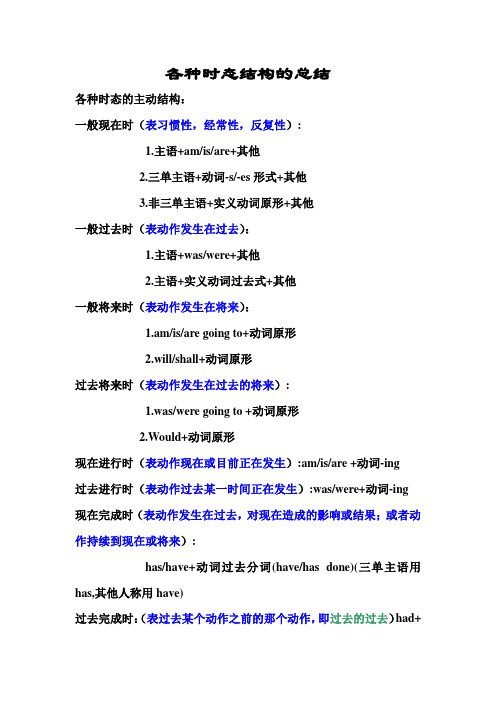
各种时态结构的总结各种时态的主动结构:一般现在时(表习惯性,经常性,反复性):1.主语+am/is/are+其他2.三单主语+动词-s/-es形式+其他3.非三单主语+实义动词原形+其他一般过去时(表动作发生在过去):1.主语+was/were+其他2.主语+实义动词过去式+其他一般将来时(表动作发生在将来):1.am/is/are going to+动词原形2.will/shall+动词原形过去将来时(表动作发生在过去的将来):1.was/were going to +动词原形2.Would+动词原形现在进行时(表动作现在或目前正在发生):am/is/are +动词-ing过去进行时(表动作过去某一时间正在发生):was/were+动词-ing 现在完成时(表动作发生在过去,对现在造成的影响或结果;或者动作持续到现在或将来):has/have+动词过去分词(have/has done)(三单主语用has,其他人称用have)过去完成时:(表过去某个动作之前的那个动作,即过去的过去)had+动词过去分词(had done)各种时态的被动结构:(done指过去分词)一般现在时:am/is/are done一般过去时:was/were done一般将来时:1,shall/will be done2, am/is/are going to be done 过去将来时:1,would be done2, was/were going to be done 现在进行时:am/is/are being done过去进行时:was/were being done现在完成时:have/has been done过去完成时:had been done含情态动词的被动结构:情态动词+be done 不定式的被动结构:“to be done”。
被动语态和主动语态
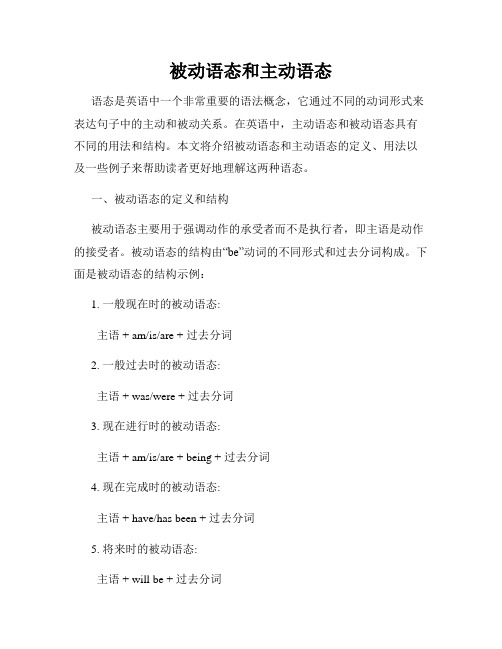
被动语态和主动语态语态是英语中一个非常重要的语法概念,它通过不同的动词形式来表达句子中的主动和被动关系。
在英语中,主动语态和被动语态具有不同的用法和结构。
本文将介绍被动语态和主动语态的定义、用法以及一些例子来帮助读者更好地理解这两种语态。
一、被动语态的定义和结构被动语态主要用于强调动作的承受者而不是执行者,即主语是动作的接受者。
被动语态的结构由“be”动词的不同形式和过去分词构成。
下面是被动语态的结构示例:1. 一般现在时的被动语态:主语 + am/is/are + 过去分词2. 一般过去时的被动语态:主语 + was/were + 过去分词3. 现在进行时的被动语态:主语 + am/is/are + being + 过去分词4. 现在完成时的被动语态:主语 + have/has been + 过去分词5. 将来时的被动语态:主语 + will be + 过去分词二、被动语态的用法被动语态主要用于以下情况:1. 当我们不知道或不关心动作的执行者时,使用被动语态。
例如:该书已经被人借走了。
-- The book has been borrowed.2. 当我们想要强调动作的接受者时,使用被动语态。
例如:这个贸易协定将使两国之间的关系更加紧密。
-- This trade agreement will make the relationship between the two countries closer.3. 当动作执行者明确但并不重要时,使用被动语态。
例如:这本小说是由一位年轻的作家所写。
-- This novel was written by a young writer.三、主动语态的定义和结构主动语态是最常用的语态,它表示主语是动作的执行者。
主动语态的结构通常更简洁,由主语、动词和宾语构成。
下面是主动语态的结构示例:1. 一般现在时的主动语态:主语 + 动词 + 宾语2. 一般过去时的主动语态:主语 + 动词 + 宾语3. 现在进行时的主动语态:主语 + am/is/are + 动词 + 宾语4. 现在完成时的主动语态:主语 + have/has + 动词 + 宾语5. 将来时的主动语态:主语 + will + 动词 + 宾语四、主动语态的用法主动语态是最常用的语态形式,用于以下情况:1. 当我们想要强调动作的执行者时,使用主动语态。
16种时态及语态总结
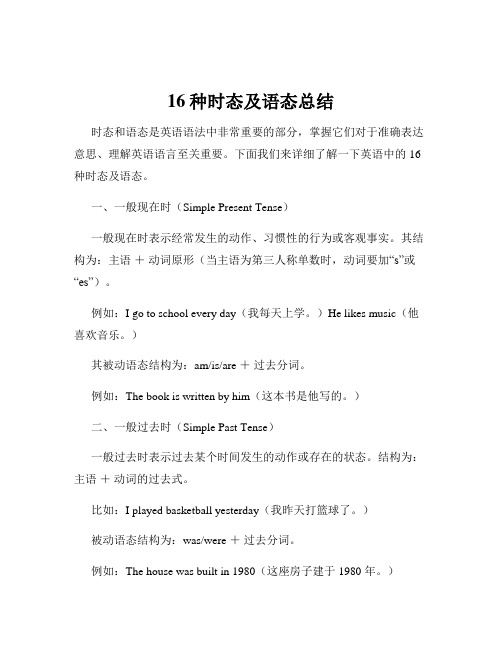
16种时态及语态总结时态和语态是英语语法中非常重要的部分,掌握它们对于准确表达意思、理解英语语言至关重要。
下面我们来详细了解一下英语中的 16 种时态及语态。
一、一般现在时(Simple Present Tense)一般现在时表示经常发生的动作、习惯性的行为或客观事实。
其结构为:主语+动词原形(当主语为第三人称单数时,动词要加“s”或“es”)。
例如:I go to school every day(我每天上学。
)He likes music(他喜欢音乐。
)其被动语态结构为:am/is/are +过去分词。
例如:The book is written by him(这本书是他写的。
)二、一般过去时(Simple Past Tense)一般过去时表示过去某个时间发生的动作或存在的状态。
结构为:主语+动词的过去式。
比如:I played basketball yesterday(我昨天打篮球了。
)被动语态结构为:was/were +过去分词。
例如:The house was built in 1980(这座房子建于 1980 年。
)三、一般将来时(Simple Future Tense)一般将来时表示将来要发生的动作或存在的状态。
结构有多种,常见的有:will +动词原形;be going to +动词原形。
例如:I will visit my grandparents next week(下周我将去看望我的祖父母。
)She is going to have a party(她打算举办一个聚会。
)其被动语态结构为:will be +过去分词;be going to be +过去分词。
比如:The meeting will be held tomorrow(会议将在明天举行。
)The show is going to be cancelled(这个演出将要被取消。
)四、现在进行时(Present Continuous Tense)现在进行时表示正在进行的动作。
各种时态的主动、被动语态结构表
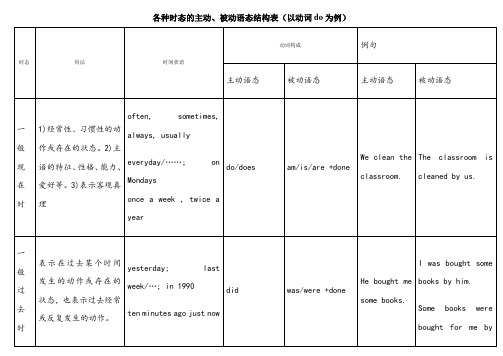
was/were+done
Hebought me some books.
I was bought some booksby him.
Some books were bought for me byhim.
现在进行
1)表示此时此刻或现阶段正在进行或持续的动作
now, these days等或当句中含有look, listen之类的暗示词时
am/is/are+doing
am/is/are+being+done
She is watering the flowers.
The flowers are being made by her.
过去进行
表示在过去某一时刻或过erday, at that time, then, at ten yesterday, from 7:00 to 9:00 last night
had+done
had been+done
They had told me the newsby 9 o’clock yesterday.
I had been told the news by 9 o’clock yesterday.
The news had been told to me by 9 o’clock yesterday.
was/were+doing
was/were+being+done
I wasplanting treesthis time yesterday .
Trees were being planted by me this time yesterday.
一般将来时
英语各时态的主动句和被动句

一般将来时(Simple Future):主动语态:明天我将会见我的朋友。
(I will meet my friend tomorrow.)被动语态:我的朋友将被我明天见到。
(My friend will be met by me tomorrow.)主动语态:下个月我将搬到一个新的城市。
(I will move to a new city next month.)被动语态:一个新的城市将被我下个月搬到。
(A new city will be moved to by me next month.)主动语态:明年我将开始学习弹钢琴。
(I will start learning to play the piano next year.)被动语态:学习弹钢琴将被我明年开始。
(Learning to play the piano will be started by me next year.)现在进行时(Present Continuous):主动语态:我正在看电视节目。
(I am watching a TV show.)被动语态:电视节目正在被我观看。
(A TV show is being watched by me.)主动语态:他们正在制定新的计划。
(They are making new plans.)被动语态:新的计划正在被他们制定。
(New plans are being made by them.)主动语态:我们正在等待朋友的到来。
(We are waiting for our friend's arrival.)被动语态:朋友的到来正在被我们等待。
(Our friend's arrival is being waited for by us.)现在完成时(Present Perfect):主动语态:我已经完成了我的工作报告。
(I have finished my work report.)被动语态:我的工作报告已经被我完成了。
各种时态的主动、被动语态结构表
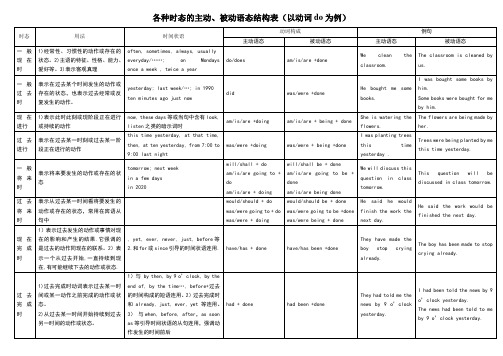
时态
用法
时间状语
动词构成
例句
主动语态
被动语态
主动语态
被动语态
一般现在时
1)经常性、习惯性的动作或存在的状态。2)主语的特征、性格、能力、爱好等。3)表示客观真理
often,sometimes,always,usually
everyday/……; on Mondaysonce a week,twice a year
过去完成时
1)过去完成时动词表示过去某一时间或某一动作之前完成的动作或状态。
2)从过去某一时间开始持续到过去另一时间的动作或状态。
1)与by then,by 9 o’clock,by the endof,by the time…,before+过去的时间构成的短语连用。2)过去完成时和already, just, ever, yet等连用。3)与when, before, after,as soon as等引导时间状语的从句连用,强调动作发生的时间前后
did
was/were+done
Hebought me some books.
I was bought some booksby him.
Some books were bought for me by him.
现在进行
1)表示此时此刻或现阶段正在进行或持续的动作
now, these days等或当句中含有look, listen之类的暗示词时
was/were going to be+done
was/were being+done
He said he would finish the work the next day.
16种时态及语态总结

16种时态及语态总结在英语学习中,时态和语态是非常重要的语法知识点。
掌握好时态和语态,能够让我们更准确、清晰地表达自己的想法和描述各种情况。
接下来,就让我们一起详细了解一下英语中的 16 种时态及语态。
一、一般现在时(Simple Present Tense)一般现在时表示经常发生的动作、习惯性的行为或客观事实、真理等。
其结构为:主语+动词原形(当主语为第三人称单数时,动词要加“s”或“es”)例如:I go to school every day (我每天上学。
)He likes playing football (他喜欢踢足球。
)主动语态:主语+动词原形/动词第三人称单数形式被动语态:am/is/are +过去分词二、一般过去时(Simple Past Tense)一般过去时用于表示过去某个时间发生的动作或存在的状态。
结构:主语+动词的过去式例如:I played basketball yesterday (我昨天打篮球了。
)主动语态:主语+动词的过去式被动语态:was/were +过去分词三、一般将来时(Simple Future Tense)一般将来时表示将来要发生的动作或存在的状态。
结构:will +动词原形或者 be going to +动词原形例如:I will visit my grandparents next week (我下周要去看望我的祖父母。
)主动语态:will +动词原形或者 be going to +动词原形被动语态:will be +过去分词或者 be going to be +过去分词四、过去将来时(Past Future Tense)过去将来时主要用于描述过去某个时间点看来将要发生的动作或存在的状态。
结构:would +动词原形或者 was/were going to +动词原形例如:He said he would come the next day (他说他第二天会来。
最新各种时态的主动、被动语态结构表
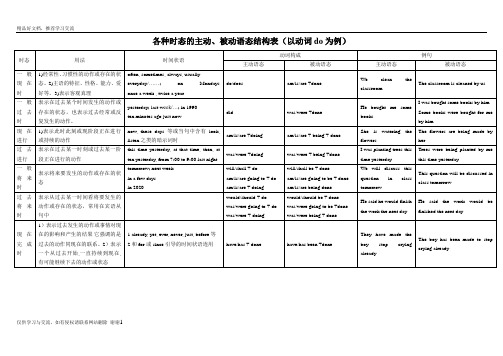
各种时态的主动、被动语态结构表(以动词do为例)1过去完成时1)过去完成时动词表示过去某一时间或某一动作之前完成的动作或状态。
2)从过去某一时间开始持续到过去另一时间的动作或状态。
1)与by then, by 9 o’clock, by the end of,by the time…, before+过去的时间构成的短语连用。
2)过去完成时和already, just,ever, yet 等连用。
3)与when, before,after,as soon as等引导时间状语的从句连用,强调动作发生的时间前后had + done had been +doneThey had told me thenews by 9 o’clockyesterday.I had been told the news by 9o’clock yesterday.The news had been told to me by9 o’clock yesterday.含有情态动词can/may/must do can/may/must be doneWe must take goodcare of the old.The old must be take good care ofby us.高二地理试卷(2019.2)(中东、中亚)一、单选题(共25题;共75分)中巴经济走廊起点位于新疆喀什,终点在巴基斯坦瓜德尔港,全长约3 000千米,北接“丝绸之路经济带”、南连“21世纪海上丝绸之路”,是一条包括公路、铁路、油气和光缆通道在内的贸易走廊。
2016年11月份,由中国新疆喀什出发的首支贸易试点车队抵达巴基斯坦瓜德尔港并将货物装船发往海外,标志着“一带一路”建设示范和先行项目的中巴经济走廊正式贯通。
据此完成下列各题。
1.中巴经济走廊途经地区()A. 地表起伏大B. 河流较多C. 高温多雨D. 黑土深厚2.新疆经中巴经济走廊对外出口的商品可能是()①天然气②稻米③棉花④葡萄干A. ①②B. ③④C. ①③D. ②④3.中巴经济走廊的建设会()A. 造成我国产业空心化B. 带动巴基斯坦基础设施建设C. 增加巴基斯坦就业压力D. 增加我国能源进口来源哈萨克首都阿斯塔纳成功申办2017年世博会,将成为首次由中亚国家举办的世博会。
16种时态的主动结构被动结构例句英语

时态是英语语法中的重要部分,它用于表示动作或状态发生的时间。
英语中共有16种时态,包括四种基本时态和它们的进行时态、完成时态、完成进行时态、将来时态和将来进行时态及其被动结构。
掌握这些时态及其被动结构对于学习英语的人来说至关重要。
本文将对这些时态和被动结构进行详细介绍,并举例说明其用法。
一、一般现在时(Simple Present Tense)一般现在时用于表示习惯性、经常性或普遍性的动作或状态。
在肯定句中,主语和谓语动词构成一般现在时;在否定句和疑问句中,则需在动词前加助动词do或does。
例句:1. He watches TV every night.2. They don’t like swimming.3. Do you speak English?二、一般过去时(Simple Past Tense)一般过去时用于表示过去某个时间发生的动作或状态。
在肯定句中,谓语动词用过去式;在否定句和疑问句中,需要在动词前加助动词did。
例句:1. She visited her grandparents last weekend.2. They didn’t go to the party.3. Did you finish your homework?......(文章内容继续展开)十五、将来完成进行时(Future Perfect Continuous Tense)将来完成进行时表示将来某个时间开始,一直持续到另一时刻,并且动作将继续进行。
它由will + have been + 现在分词构成。
例句:1. By the end of this year, I will have been studying English for 10 years.2. By the time he arrives, they will have been waiting for two hours.十六、被动结构(Passive Voice)被动语态是英语中一种重要的句式结构,它常用于强调动作的承受者或者强调行为发出者。
六大主动时态和被动语态的结构

被动 主+have/has+been done(过去分词)
标志词:already, yet, just,so for,since,for,ever…
翰辰英语涂老师!
学生Cherry.郭昕怡
THANKS !!!
致力为企业和个人提供合同协议,策划案计划书,学习课件等等
主+ (am/is/are)going to+v.原
主+(am/is/are)+Ving(备注:短暂性动词的ing形式)
被动 主+will/shall+be(原型)+done(过去分词)
标志词:tomorrow、next…、the day after tomorrow,
4.现在进行时:主动 主+am/is/are+V-ing
六大时态的主动和被动语态
的句型基本结构:
be+done(过去分词)+(by sb.)
1.一般现在时:主动结构 a. 主+be(am/is/are)
b. 主+v.原或v.三单
被动结构 主+ am/is/are+done(过去分词)
标志词:always、often、every…、usually、sometimes等
被动 主+am/is/are being done(过去分词) 标志词: now,look,listen,at the moment
5.过去进行时:主动 主+was/were+V.ing
被动 主+was/were being done(过去分词)
标志词: at that time,具体的时间点+过去的时间
8种时态的被动语态

动词的语态:主动语态和被动语态被动语态的基本结构:Be + done(过去分词)1、一般现在时:(主动语态)I help you.发出者动词承受者变为被动语态:Do——am/is/are doneYou are helped by me.承受者谓语发出者2、一般过去时的被动:did——was/were done(I helped you.-每个例子可让学生自己先尝试变被动,再给答案)3、一般将来时的被动:Will do——will be done(I will help you.-)4、现在进行时的被动:Am/is/are doing ——Am/is/are being done(I am helping you.-)5、过去进行时的被动:Was/were doing——Was/were being done(I was helping you.-)6、现在完成时的被动:Have done——have been done (I have helped you.-)7、过去完成时的被动:Had done——had been done (I had helped you.-)8、过去将来时的被动:Would do ——would be done (I would help you.-)答案:2、You were helped by me.3、You will be helped by me.4、You are being helped by me.5、You were being helped by me.6、You have been helped by me.7、You had been helped by me.8、You would be helped by me.。
各时态的被动语态的基本结构
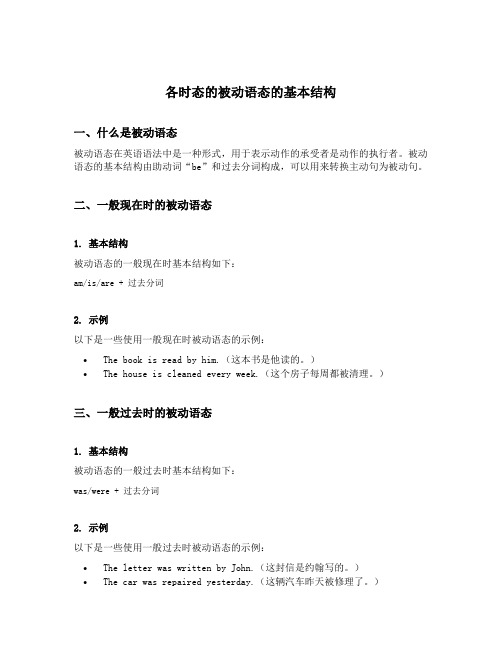
各时态的被动语态的基本结构一、什么是被动语态被动语态在英语语法中是一种形式,用于表示动作的承受者是动作的执行者。
被动语态的基本结构由助动词“be”和过去分词构成,可以用来转换主动句为被动句。
二、一般现在时的被动语态1. 基本结构被动语态的一般现在时基本结构如下:am/is/are + 过去分词2. 示例以下是一些使用一般现在时被动语态的示例:•The book is read by him.(这本书是他读的。
)•The house is cleaned every week.(这个房子每周都被清理。
)三、一般过去时的被动语态1. 基本结构被动语态的一般过去时基本结构如下:was/were + 过去分词2. 示例以下是一些使用一般过去时被动语态的示例:•The letter was written by John.(这封信是约翰写的。
)•The car was repaired yesterday.(这辆汽车昨天被修理了。
)四、一般将来时的被动语态1. 基本结构被动语态的一般将来时基本结构如下:will + be + 过去分词2. 示例以下是一些使用一般将来时被动语态的示例:•The project will be finished next week.(这个项目将在下周完成。
)•The cake will be eaten at the party.(这个蛋糕将在派对上被吃掉。
)五、现在进行时的被动语态1. 基本结构被动语态的现在进行时基本结构如下:am/is/are + being + 过去分词2. 示例以下是一些使用现在进行时被动语态的示例:•The house is being built by a construction company.(这个房子正在被一家建筑公司建造。
)•The project is being discussed in the meeting.(这个项目正在会议中讨论。
一般现在时态被动和主动时态的结构
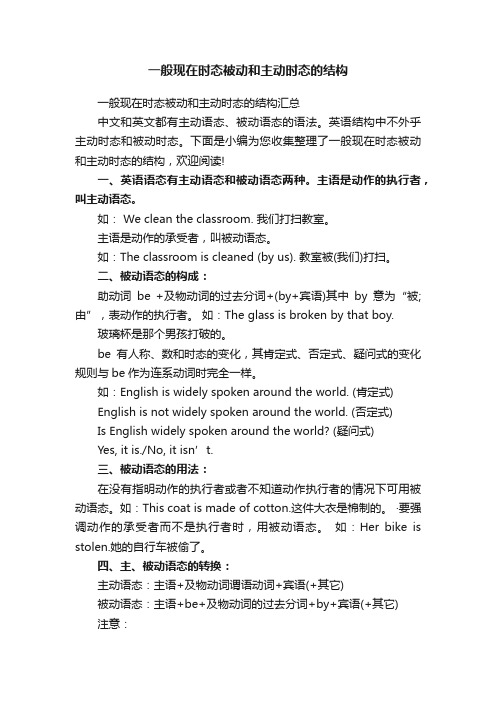
一般现在时态被动和主动时态的结构一般现在时态被动和主动时态的结构汇总中文和英文都有主动语态、被动语态的语法。
英语结构中不外乎主动时态和被动时态。
下面是小编为您收集整理了一般现在时态被动和主动时态的结构,欢迎阅读!一、英语语态有主动语态和被动语态两种。
主语是动作的执行者,叫主动语态。
如: We clean the classroom. 我们打扫教室。
主语是动作的承受者,叫被动语态。
如:The classroom is cleaned (by us). 教室被(我们)打扫。
二、被动语态的构成:助动词be +及物动词的过去分词+(by+宾语)其中by意为“被;由”,表动作的执行者。
如:The glass is broken by that boy.玻璃杯是那个男孩打破的。
be有人称、数和时态的变化,其肯定式、否定式、疑问式的变化规则与be作为连系动词时完全一样。
如:English is widely spoken around the world. (肯定式)English is not widely spoken around the world. (否定式)Is English widely spoken around the world? (疑问式)Yes, it is./No, it isn’t.三、被动语态的用法:在没有指明动作的执行者或者不知道动作执行者的情况下可用被动语态。
如:This coat is made of cotton.这件大衣是棉制的。
·要强调动作的承受者而不是执行者时,用被动语态。
如:Her bike is stolen.她的自行车被偷了。
四、主、被动语态的转换:主动语态:主语+及物动词谓语动词+宾语(+其它)被动语态:主语+be+及物动词的过去分词+by+宾语(+其它)注意:1. 主动、被动互转时,时态不变,但有人称和数的变化。
主动句的主语是代词的主格形式,变成被动态by的宾语时,要用宾格形式。
初中英语被动语态的构成及用法归纳大全

初中英语被动语态的构成及用法归纳大全被动语态是英语中的一种重要语法结构,用于表达动作的承受者或主语受动作影响的情况。
初中阶段是研究英语被动语态的关键时期,本文将对初中英语被动语态的构成和用法进行归纳总结。
构成被动语态被动语态的构成主要通过动词的变化来实现。
通常由be动词(am, is, are, was, were等)加上动词的过去分词构成。
以下是不同时态的被动语态构成:1. 现在时态:- 一般现在时:主语 + is/are + 过去分词- 现在进行时:主语 + am/are + being + 过去分词2. 过去时态:- 一般过去时:主语 + was/were + 过去分词- 过去进行时:主语 + was/were + being + 过去分词3. 将来时态:- 将来进行时:主语 + will be + being + 过去分词被动语态的用法被动语态在英语中具有广泛应用。
下面是一些常见的被动语态用法:1. 强调动作的承受者:被动语态可以突出动作的承受者,而不强调执行动作的人或物。
- The book was written by Mark Twain.(这本书是马克·吐温写的。
)2. 表达一般真理:有些句子使用被动语态来表达普遍真理或客观事实。
- Cats are loved by many people.(猫被很多人喜欢。
)3. 不知道或不关心动作的执行者:有时我们并不关心动作的执行者,只关注动作本身及其结果。
- The cake has been eaten.(蛋糕已经被吃掉了。
)4. 搭配某些及物动词:某些及物动词通常与被动语态搭配使用。
- The car was repaired by a mechanic.(汽车被一位修理工修好了。
)5. 表达被动语态的主动含义:有时被动语态可以表达主动意义,特别是在科学和技术文献中。
- The chemical reaction is triggered by heat.(这个化学反应是由热引发的。
16种时态及语态总结

16种时态及语态总结在英语学习中,时态和语态是非常重要的语法知识点。
它们能够帮助我们准确地表达时间、动作的状态以及主语和动词之间的关系。
下面就让我们一起来详细了解一下这 16 种时态及语态。
一、一般现在时(Simple Present Tense)一般现在时表示经常发生的动作、习惯性的行为、客观事实或真理等。
其结构为:主语+动词原形(当主语为第三人称单数时,动词要加“s”或“es”)例如:I play basketball every day (我每天打篮球。
)He likes music (他喜欢音乐。
)其被动语态结构为:am/is/are +过去分词例如:The book is read by many people (这本书被很多人读。
)二、一般过去时(Simple Past Tense)一般过去时用于描述过去发生的动作或存在的状态。
结构为:主语+动词的过去式比如:I went to Beijing last year (我去年去了北京。
)被动语态结构为:was/were +过去分词例如:The house was built in 1990、(这座房子建于 1990 年。
)三、一般将来时(Simple Future Tense)一般将来时表示将来要发生的动作或存在的状态。
结构有:will +动词原形或者 be going to +动词原形比如:I will visit my grandparents next week (下周我将看望我的祖父母。
)He is going to have a party tomorrow (他明天打算举办一个派对。
)其被动语态结构为:will be +过去分词或者 be going to be +过去分词例如:The meeting will be held next month (会议将在下个月举行。
)四、现在进行时(Present Continuous Tense)现在进行时表示正在进行的动作。
各时态的结构
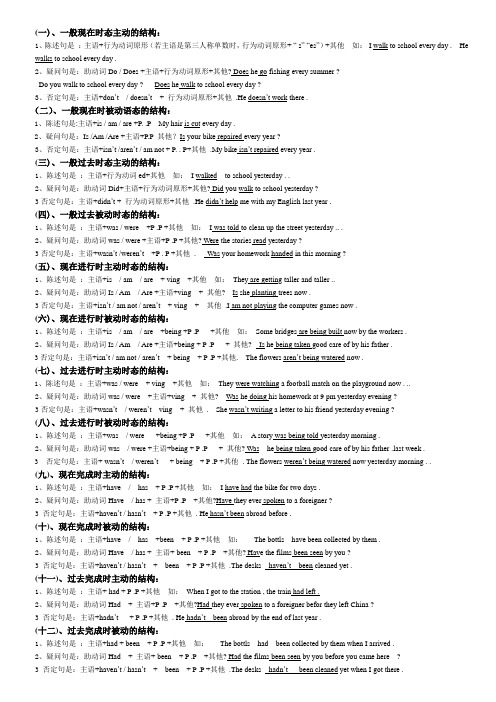
(一)、一般现在时态主动的结构:1、陈述句是:主语+行为动词原形(若主语是第三人称单数时,行为动词原形+ “ s” “es”)+其他如:I walk to school every day . He walks to school every day .2、疑问句是:助动词Do / Does +主语+行为动词原形+其他? Does he go fishing every summer ?Do you walk to school every day ? Does he walk to school every day ?3、否定句是:主语+don’t / doesn’t + 行为动词原形+其他.He doesn’t work there .(二)、一般现在时被动语态的结构:1、陈述句是:主语+is / am / are +P. .P My hair is cut every day .2、疑问句是:Is /Am /Are +主语+P.P 其他?Is your bike repaired every year ?3、否定句是:主语+isn’t /aren’t / am not + P. . P+其他.My bike isn’t repaired every year .(三)、一般过去时态主动的结构:1、陈述句是:主语+行为动词ed+其他如:I walked to school yesterday . .2、疑问句是:助动词Did+主语+行为动词原形+其他? Did you walk to school yesterday ?3否定句是:主语+didn’t + 行为动词原形+其他.He didn’t help me with my English last year .(四)、一般过去被动时态的结构:1、陈述句是:主语+was / were +P .P +其他如:I was told to clean up the street yesterday .. .2、疑问句是:助动词was / were +主语+P .P +其他? Were the stories read yesterday ?3否定句是:主语+wasn’t /weren’t +P . P +其他. Was your homework handed in this morning ?(五)、现在进行时主动时态的结构:1、陈述句是:主语+is / am / are + ving +其他如:They are getting taller and taller ..2、疑问句是:助动词Is / Am / Are +主语+ving + 其他? Is she planting trees now .3否定句是:主语+isn’t / am not / aren’t + ving + 其他.I am not playing the computer games now .(六)、现在进行时被动时态的结构:1、陈述句是:主语+is / am / are +being +P .P +其他如:Some bridges are being built now by the workers .2、疑问句是:助动词Is / Am / Are +主语+being + P .P + 其他? Is he being taken good care of by his father .3否定句是:主语+isn’t / am not / aren’t + being + P .P +其他. The flowers aren’t being watered now .(七)、过去进行时主动时态的结构:1、陈述句是:主语+was / were + ving +其他如:They were watching a football match on the playground now . ..2、疑问句是:助动词was / were +主语+ving + 其他? Was he doing his homework at 9 pm yesterday evening ?3否定句是:主语+wasn’t / weren’t ving + 其他. She wasn’t writing a letter to his friend yesterday evening ?(八)、过去进行时被动时态的结构:1、陈述句是:主语+was / were +being +P .P +其他如: A story was being told yesterday morning .2、疑问句是:助动词was / were +主语+being + P .P + 其他? Was he being taken good care of by his father .last week .3 否定句是:主语+ wasn’t / weren’t + being + P .P +其他. The flowers weren’t being watered now yesterday morning . .(九)、现在完成时主动的结构:1、陈述句是:主语+have / has + P .P +其他如:I have had the bike for two days .2、疑问句是:助动词Have / has + 主语+P .P +其他?Have they ever spoken to a foreigner ?3 否定句是:主语+haven’t / hasn’t + P .P +其他. He hasn’t been abroad before .(十)、现在完成时被动的结构:1、陈述句是:主语+have / has +been + P .P +其他如:The bottls have been collected by them .2、疑问句是:助动词Have / has + 主语+ been + P .P +其他? Have the films been seen by you ?3 否定句是:主语+haven’t / hasn’t + been + P .P +其他.The desks haven’t been cleaned yet .(十一)、过去完成时主动的结构:1、陈述句是:主语+ had + P .P +其他如:When I got to the station , the train had left .2、疑问句是:助动词Had + 主语+P .P +其他?Had they ever spoken to a foreigner befor they left China ?3 否定句是:主语+hadn’t + P .P +其他. He hadn’t been abroad by the end of last year .(十二)、过去完成时被动的结构:1、陈述句是:主语+had + been + P .P +其他如:The bottls had been collected by them when I arrived .2、疑问句是:助动词Had + 主语+ been + P .P +其他? Had the films been seen by you before you came here ?3 否定句是:主语+haven’t / hasn’t + been + P .P +其他.The desks hadn’t been cleaned yet when I got there .(十三)、一般将来时主动的结构:1、陈述句是:主语+will /shall + v + 其他如:I will write to her tomorrow .2、疑问句是:助动词will /shall + 主语+ v + 其他Will you write a composition about the environ ment ?3、否定句是:主语+won’t / shall not + v +其他. He won’t give me a hand this evening .(十四)、一般将来时被动的结构:1、陈述句是:主语+will /shall + be +P .P + 其他如:My homework will be finished this evening .2、疑问句是:助动词will /shall + 主语+ be +P .P + 其他Will a composition be written by you this evening ?3、否定句是:主语+won’t / shall not + v +其他A bridge won’t be built this year .(十五)、过去将来时主动的结构:1、陈述句是:主语+would + v + 其他如:She said she would write to me tomorrow .2、疑问句是:助动词would l + 主语+ v + 其他Iasked him if he would write a composition about the environ ment ?3、否定句是:主语+wouldn’t + v +其他. He told me he wouldn’t give me a hand this evening .(十六)、过去将来时被动的结构:1、陈述句是:主语+would + be +P .P + 其他如:My homework will be finished this evening .2、疑问句是:助动词would + 主语+ be +P .P + 其他3、否定句是:主语+would + v +其他He told me a bridge wouldn’t be built this year。
英语时态结构及被动语态

被动语态比较主动语态与被动语态:(主动)The office (被动)(主动)The office was (被动)1、一般现在时的被动结构:am/is/are+done(过去分词)如:People in China speak Chinese. Chinese is spoken by people in China.2、一般过去时的被动结构:was/were+done如:Tom bought some cakes. Some cakes were bought by Tom.3、一般将来时的被动结构:shall/will be done.如:Our school will hold a sports meeting. A sports meeting will be held by our school.4、情态动词的被动结构:must/may/can/need/should+be done.如:We must send her to hospital. She must be sent to hospital by us.5、现在完成时的被冻结构:have/has been done.如:He has learned many words. Many words have been learned by him.6、现在进行时的被动结构:am/is/are being done如:the office is being cleaned at the moment.比较主动语态与被动语态(主动)The door is being painted7、感官动词没有被动,总是用于一般现在时或一般过去时基本时态1、一般现在时:用来表示一般性的事实或有时或往往发生的事情主语+动词标志词:always/never/often/sometimes/usually 等频度副词如:I like big cities. I don't like big cities.The shop open at 9 o'clock and close at 5.30.Sue always arrives at work early.I usually go to work by car but sometimes I walk.2、现在进行时am/is/are+doing如:Tom is having a shower at the moment.You can turn off the television.I'm not watching it.这些动词不用于现在进行时:Like/love/want/know/understand/remember/depend/prefer/ hate/need/mean/believe/forget如:I'm tired.I want to go home.(而非I'm wanting)‘Do you know that girl?’‘Yes,but I don't remember her name.’3、一般过去时:主语+动词过去时如:I/we/you/they/he/she/it+watchedThey watched television yesterday evening.①否定式:可用did/didn't+动词原形如:We went to the cinema but we didn't enjoy the film.②疑问句:did+主语+动词原形如:What did your sister phone you?Where did your parents go for their holiday?4、过去进行时was/were+doing如:What were you doing at 11:30 yesterday? Were you working?In 1985 we were living in Canada.5、现在完成时:have/has+done①表示过去发生的而现在有结果的动作如:I've lost my passport. (我现在找不到我的护照)We've bought a new car.(我们现在有了一辆新车)标志词:just/already/yetWe've already met.②谈论从过去到现在的一段时间如一个人的一生时,用现在完成时(have been/have had/have played)如:Have you ever been to Japan?(从过去到现在)‘Have you been to France?’(一生中)‘No,I haven't.’现在完成进行时+ ever (疑问句中)与never比较:‘Has Ann ever been to Australia?’‘Yes,once.’(once表示“一次”) My mother has never travelled bu air.(从来没有)④gone与been比较:Bill has gone to Spain.(他现在在西班牙)Bill has been to Spain.(他去了西班牙但是现在回来了,即曾经去过/到过)6、过去完成时:had+done表示发生的时间是“过去的过去”,侧重事情的结果如:When I woke up,it had already stopped raining.I had finished reading the novel by nine o'clock last night.。
- 1、下载文档前请自行甄别文档内容的完整性,平台不提供额外的编辑、内容补充、找答案等附加服务。
- 2、"仅部分预览"的文档,不可在线预览部分如存在完整性等问题,可反馈申请退款(可完整预览的文档不适用该条件!)。
- 3、如文档侵犯您的权益,请联系客服反馈,我们会尽快为您处理(人工客服工作时间:9:00-18:30)。
主+ (am/is/are)going to+v.原
主+(am/is/are)+Ving(备注:短暂性动词的ing形式)
被动 主+will/shall+be(原型)+done(过去分词)
标志词:tomorrow、next…、the day after tomorrow,
THANKS !!!
致力为企业和个人提供合同协议,策划案计划书,学习课件等等
打造全网一站式需求
欢迎您的下载,资料仅供参考
4.现在进行时:主动 主+am/is/are+V-ing
被动 主+am/is/are being done(过去分词) 标志词: now,look,listen,at the moment
5.过去进行时:主动 主+was/were+V.ing
被动 主+was/were being done(过去分词)
标志词: at that time,具体的时间点+过去的时间
6.现在完成时:主动 主+have/has done(过去分词)
被动 主+have/has+been done(过去分词)
标志词:already, yet, just,so for,since,for,ever…
翰辰英语涂老师!
学生Cherry.郭昕怡
标志词:always、often、every…、usually、sometimes等
2.一般过去时:主动 a.主+was/were+n./adj./介词短语
b.主+v.过去式
被动 主+was/were+done(过去分词)
标志词:…ago、just now、yesterday、the day before yesterday、last…
郭昕怡学习课件等等thanks致力为企业和个人提供合同协议策划案计划书打造全网一站式需求欢迎您的下载资料仅供参考
六大时态的主动和被动语态
的句型基本结构:
be+done(过去分词)+(Байду номын сангаасy sb.)
1.一般现在时:主动结构 a. 主+be(am/is/are)
b. 主+v.原或v.三单
被动结构 主+ am/is/are+done(过去分词)
